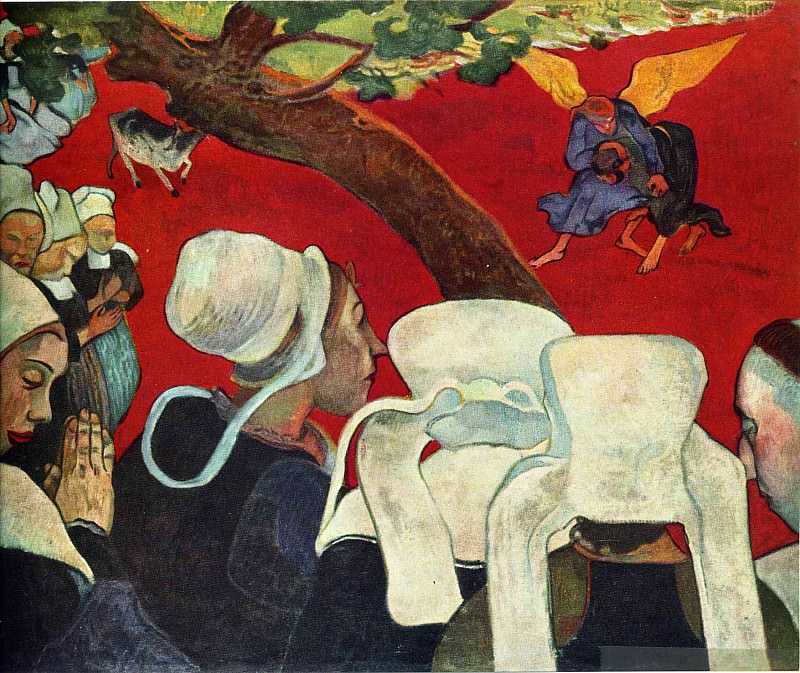img171 Paul Gauguin (1848-1903)
Paul Gauguin – img171
Edit attribution
Download full size: 2245×1887 px (0,3 Mb)
Painter: Paul Gauguin
"The Vision After the Sermon" is the artist’s first work on the theme of faith. Gauguin painted it under the great impression of the religiosity of the Breton women we see on the canvas. The painting attracts attention by its composition. It looks as if it is divided diagonally by a tree trunk. This symbolic technique, borrowed from Japanese tradition, is intended to distinguish between the lower part, where we see the women praying and the preacher, and the upper part, where the action takes place - the story of Jacob’s struggle with the angel.
Description of Paul Gauguin’s painting "The Vision After the Sermon"
"The Vision After the Sermon" is the artist’s first work on the theme of faith. Gauguin painted it under the great impression of the religiosity of the Breton women we see on the canvas.
The painting attracts attention by its composition. It looks as if it is divided diagonally by a tree trunk. This symbolic technique, borrowed from Japanese tradition, is intended to distinguish between the lower part, where we see the women praying and the preacher, and the upper part, where the action takes place - the story of Jacob’s struggle with the angel. In this way the author wants to emphasize the contrast between the real world and the spiritual world.
To Jacob, the hero of Genesis, God descends in the form of an angel. Man wrestles with him in his quest for blessing and the forgiveness of his sins. Some sources claim that figuratively Jacob was not wrestling with God, but with his fear and mistrust.
Although female figures in national costumes are depicted in the foreground and occupy most of the painting, attention is focused on the biblical motif. This effect is achieved through deliberate contrast in the use of colors, dynamics, and rhythm. The lower part is static and executed in strict, repetitive color combinations. The upper one is energetic, bright and metaphorical.
A cow can be seen in the upper left corner of the picture. Traditionally, ancient people sacrificed the animal, so this element duplicates the meaning of the biblical parable and symbolizes redemption and humility, a passionate desire to be forgiven.
Looking closely at the faces of the people depicted, you will notice that the preacher resembles Gauguin himself, while the woman, painted in profile, resembles the artist’s muse, Madeleine Bernard.
The work is currently in the National Gallery of Scotland in Edinburgh as one of the master’s most recognizable works, painted in the style of syntheticism.
Кому понравилось
Пожалуйста, подождите
На эту операцию может потребоваться несколько секунд.
Информация появится в новом окне,
если открытие новых окон не запрещено в настройках вашего браузера.
You need to login
Для работы с коллекциями – пожалуйста, войдите в аккаунт (open in new window).




















You cannot comment Why?
In the upper right quadrant of the painting, a more surreal element is introduced: a winged figure, possibly an angel, is shown wrestling with or assisting another figure, who is in turn grappling with a dark, animal-like form. This juxtaposition of the earthly and the divine, the mundane and the mystical, is a hallmark of Symbolism.
The subtexts of this painting likely explore themes of faith, spirituality, and the unknown. The intense red background evokes passion, spirituality, or even a sense of danger or the supernatural. The traditional dress of the women suggests a connection to cultural heritage and perhaps a simpler, more devout way of life. The wrestling angel figure introduces an element of spiritual struggle, perhaps representing the battle between good and evil, or the internal conflicts of faith. The presence of a goat in the background, a common symbol in religious and mythological contexts, further adds to the layers of meaning. The overall effect is one of a dreamlike or visionary experience, where spiritual realities are made manifest in a highly stylized and emotionally charged manner.